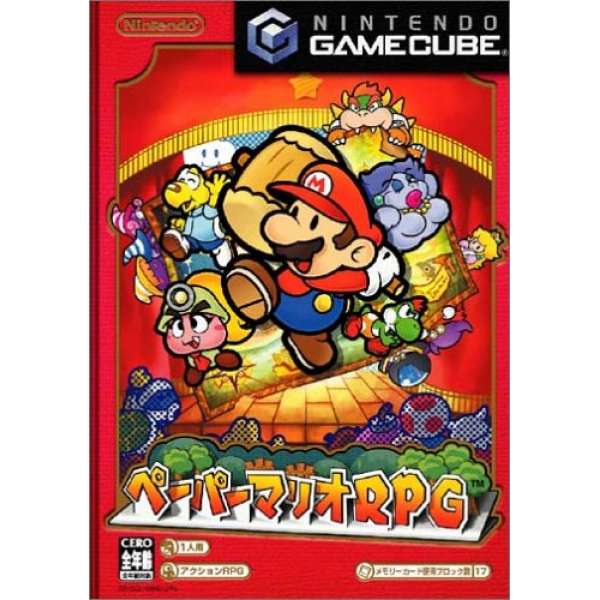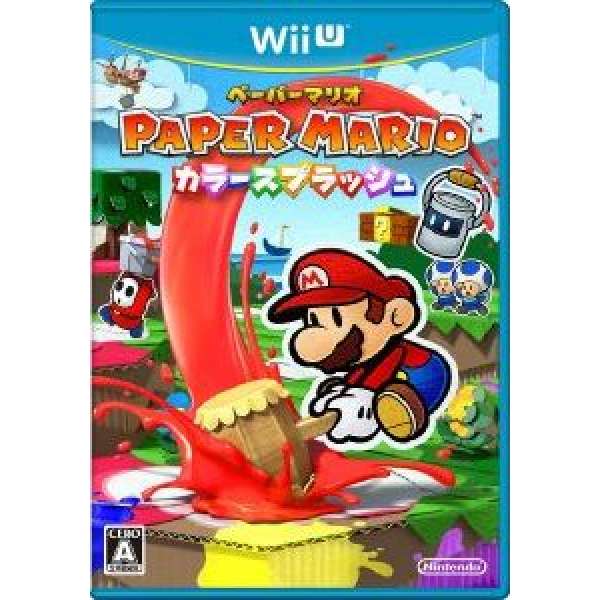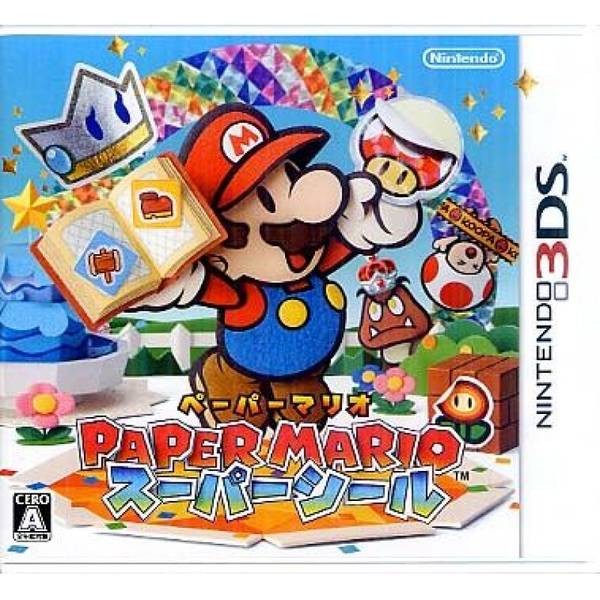超級紙片瑪利歐
《超級紙片瑪利歐》(日文:スーパーペーパーマリオ,英文:Super Paper Mario)是任天堂於2007年在Wii平台推出的動作角色扮演遊戲,由Intelligent Systems與任天堂共同開發。作為「紙片瑪利歐」系列的第三部作品,延續前作的紙張美術風格與幽默敘事,同時大膽轉型,從原本的回合制RPG改為融合平台跳躍與RPG要素的動作冒險遊戲,是該系列風格最獨特的作品之一。
在劇情方面,一改系列傳統「拯救碧姬公主」的老套套路,轉而講述更宏大、甚至帶有哲學色彩的故事。瑪利歐原本與碧姬在過著平靜日常,卻被新反派「迪門特將軍」(Count Bleck)打破。這位神秘人物以預言之書「混沌之書」為基礎,試圖打開名為「混沌之心(The Void)」的黑洞,讓所有世界歸於虛無。他綁架碧姬與庫巴,強行將兩人「結婚」,藉此觸發毀滅的預言。為阻止這場宇宙危機,瑪利歐必須找齊「純潔之心(Pure Hearts)」——能抵消混沌力量的神聖物品,展開一場跨越八個次元的冒險。
故事隨著旅程逐漸揭露角色們的真實動機,特別是反派迪門特的過去,其與被迫分離的戀人蒂娜(Timpani,即本作的女主角「Tippi」)之間的愛情悲劇,為整體劇情增添前所未有的情感深度。相較於過去以搞笑為主的風格,本作的主線敘事更具詩意與哀愁,成功塑造出關於愛、命運與自我犧牲的童話寓言。
在操作與玩法方面,最具創新性的設計,就是結合「2D與3D」的空間轉換機制。大部分時間以2D橫向卷軸形式進行,但瑪利歐獲得「次元翻轉」能力後,可以暫時將畫面轉為3D視角。在3D模式中,原本看似無路可走的場景會出現隱藏平台、通道或道具,這種「平面與立體」的切換構成大量解謎與探索的核心機制。此外,不僅操作瑪利歐,還可以切換至碧姬、庫巴與路易吉等角色。每位角色具備獨特能力:碧姬可短暫漂浮並在水上行走、庫巴能使用火焰攻擊、路易吉擁有強力跳躍。這些角色切換提供了豐富的關卡解法與戰鬥策略。還引入稱為「像素精靈(Pixls)」的輔助夥伴,每位精靈都有不同用途,例如炸開牆壁、舉起重物、解讀隱藏訊息等。這些精靈與角色能力的搭配成為過關關鍵,也延續系列強調「環境互動」的傳統特色。
在關卡設計方面,分為八大章節,每章有數個子關卡與獨立主題。從懷舊風格的像素世界、數碼監獄般的未來都市、婚禮主題的城堡迷宮,到模仿80年代RPG的奇幻村莊,每一關皆有強烈視覺與敘事風格。這種創意豐富的世界建構,讓玩家在每次進入新章節時都能感受到驚喜。此外,仍保留RPG元素,如經驗值系統、等級提升、物品收集、隱藏關卡與挑戰。戰鬥雖改為即時接觸敵人式,但仍講求技巧與搭配,特別是配合像素精靈與角色技能,可發揮多種效果。UI設計也貼合Wii遙控器操作,簡單直覺、無需複雜輸入,適合各年齡層玩家。
在美術與音樂方面,延續紙片系列風格,但在不同世界中融入更多元視覺風格,如像素藝術、馬賽克圖騰、霓虹科幻風等,使整體畫面既統一又富有變化。音樂也跟隨各章節主題作出調性轉變,既有輕快搞笑的曲目,也有抒情甚至悲傷的旋律,在氛圍營造上極具層次。
就市場評價而言,推出後獲得整體正面評價,特別是其創意操作與動人劇情廣受讚譽。許多玩家稱讚它大膽突破原有RPG框架,融入平台跳躍與解謎設計,使系列煥然一新。故事深度與角色塑造也獲得肯定,特別是迪門特與Tippi的感情線感動了許多玩家。不過也有部分傳統RPG愛好者對本作取消回合制戰鬥感到失望,認為節奏偏向動作導向,缺乏策略性。
綜合來看,這是成功的系列革新,不僅保留「紙片」世界的幽默與奇幻,更融入創新的次元玩法與戲劇性敘事。同時兼顧輕鬆操作與豐富內容,無論是老粉絲還是首次接觸的玩家,都能從中找到樂趣與感動。
Super Paper Mario (Japanese: スーパーペーパーマリオ) is an action role-playing game released by Nintendo in 2007 for the Wii platform, co-developed by Intelligent Systems and Nintendo. As the third entry in the Paper Mario series, it retains the franchise’s signature paper-crafted visual style and quirky humor, but boldly transforms its gameplay. Departing from the traditional turn-based RPG formula, it introduces a blend of platforming and role-playing elements, making it one of the most unique titles in the series.
In terms of story, the game moves away from the classic “rescue Princess Peach” trope and ventures into a grander narrative with philosophical undertones. Mario and Peach are living peacefully when a new villain, Count Bleck, disrupts their world. Using the prophetic "Dark Prognosticus," Count Bleck aims to open a void called "The Void" to destroy all worlds. He kidnaps Peach and Bowser and forces them into a wedding ceremony to trigger an apocalyptic prophecy. To prevent the collapse of the multiverse, Mario sets out to collect the "Pure Hearts" — sacred items capable of counteracting the chaos — embarking on an adventure that spans across eight dimensions.
As the journey unfolds, the deeper motivations of the characters come to light, especially Count Bleck’s tragic past. His love story with Timpani (later revealed to be Tippi, the main female protagonist of the game) adds emotional weight to the plot. Unlike the series' previous comedic focus, this game features a poetic and melancholic narrative, successfully crafting a fable-like tale of love, fate, and self-sacrifice.
The gameplay and controls introduce the groundbreaking mechanic of switching between 2D and 3D perspectives. While most of the game plays out as a side-scrolling platformer, Mario gains the ability to "flip" into a 3D viewpoint. This reveals hidden platforms, passages, or items that aren’t visible in 2D, making perspective-switching central to puzzle-solving and exploration.
Players don’t only control Mario — they can also switch to Peach, Bowser, or Luigi throughout the game. Each character has unique abilities: Peach can float and walk on water, Bowser breathes fire, and Luigi has a powerful high jump. Switching characters at the right time provides various strategies for combat and exploration.
The game also introduces “Pixls,” magical sprite companions who assist with various tasks like blowing up walls, lifting heavy objects, or revealing hidden messages. The synergy between Pixl abilities and character powers becomes essential to progressing through the game, continuing the series' tradition of environmental interaction.
Level design is split across eight main chapters, each divided into several sub-levels with distinct themes. Players explore everything from a retro pixelated world, a futuristic digital prison, and a castle-themed wedding dungeon, to a parody of 1980s fantasy RPG towns. Every chapter brings a unique visual and narrative style, constantly surprising players with creativity and variety.
RPG elements like experience points, level-ups, item collection, hidden areas, and side challenges are still present. While combat is no longer turn-based — enemies are engaged directly in real-time — it still rewards timing and strategy, particularly through the use of Pixls and character abilities. The user interface is designed with the Wii Remote in mind, offering simple, intuitive controls that are accessible for players of all ages.
Artistically, the game maintains the “paper” aesthetic while blending in diverse styles across different worlds — from pixel art and mosaic patterns to neon sci-fi settings. The music adapts accordingly, with playful, comical tunes as well as emotionally resonant, even sorrowful, compositions, greatly enhancing the game's atmosphere.
Upon release, Super Paper Mario received generally positive reviews. Critics and players praised its inventive mechanics and emotionally rich story. Many appreciated how it broke away from traditional RPG structures by merging platforming with puzzle elements, refreshing the series with new life. The character development — especially the touching backstory of Count Bleck and Tippi — struck a chord with many fans. However, some long-time RPG enthusiasts expressed disappointment at the removal of turn-based combat, feeling the action-oriented pacing lacked the strategic depth of earlier titles.
Overall, Super Paper Mario stands as a successful reinvention of the series. It preserves the humor and whimsical charm of the “Paper” world while introducing innovative gameplay and dramatic storytelling. With accessible controls and a wealth of content, it offers a memorable experience for both longtime fans and newcomers alike.
運費計算方式:
貨款滿1000元運費外加90元
貨款1000以下:買1件運費外加 60元,買2件運費外加 70元,
買3件運費外加 80元 ,買4件運費外加 90元
貨到付款外加30元手續費
外島及大陸地區運費另計
付款方式:
線上刷卡:本站採用Paypal線上刷卡
虛擬帳號匯款:屬於您專屬的虛擬帳戶,方便站長查帳使用,本站強力推薦
實體ATM匯款:請將匯款帳號記錄下來至各大銀行ATM提款機轉帳
超商條碼繳費:請列印本站提供的條碼至四大超商繳費
線上轉帳:透過玉山銀行線上ATM轉帳(此系統只支援IE瀏覽器)
貨到付款:本站採用黑貓宅急便貨到付款
其他注意事項:
如需購買線上點數卡請直接跟站長連絡,本站不提供點數卡的線上付款







